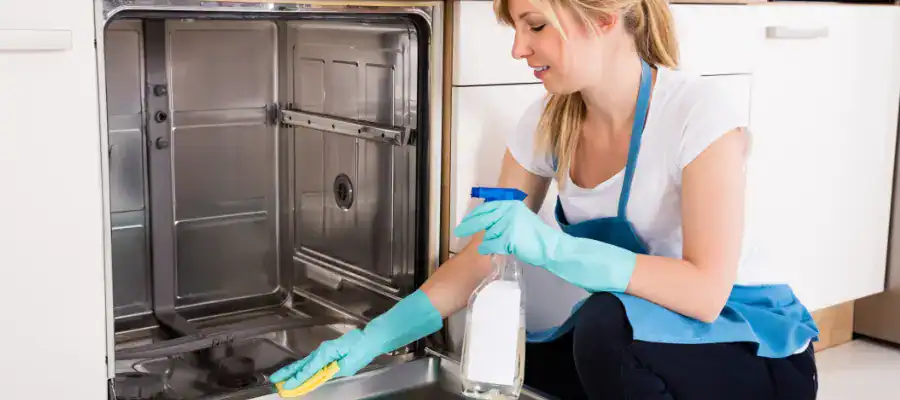The Complete Guide to Dishwasher Maintenance

A dishwasher is one of a modern home’s most time- and labor-saving appliances. But it’s also the most likely to break down. This is especially true in Southern California, where hard water accelerates wear and tear.
A poorly maintained dishwasher can leave dishes spotty and crusty or even cause leaks and electrical malfunctions.
Regular maintenance, like cleaning the filter, checking the spray arms, and ensuring proper detergent use, ensures efficient operation and can significantly extend the appliance’s life.
Benefits of Dishwasher Maintenance
- A well-maintained dishwasher cleans more effectively, saving you time and effort.
- Regular care prevents wear and tear, prolonging the lifespan of your dishwasher.
- Preventive maintenance means fewer breakdowns and less money spent on repairs or replacements.
- A clean, efficient dishwasher uses less energy and water, reducing utility bills.
How to Maintain Your Dishwasher
1. Clean the Filter Regularly
The filter traps food particles to prevent dishwasher drain clogs. These particles can build up, leading to unpleasant odors and poor cleaning performance.
Steps to clean the filter:
- Locate the filter (usually at the bottom of the dishwasher).
- Twist it out or remove it according to your dishwasher manual.
- Rinse the filter under warm water to remove debris. For stubborn residue, use a soft brush and mild detergent.
- Reinstall the filter.
Frequency: Clean the filter at least once a month.
2. Remove & Clean Spray Arms
Spray arms distribute water throughout the dishwasher. If food debris or mineral deposits clog them, your dishes won’t be as clean as you like.
Steps to clean spray arms:
- Remove the spray arms (refer to your dishwasher’s manual).
- Check for and clear clogs in the spray holes using a toothpick or small brush.
- Wash the arms under warm, soapy water.
- Reattach them securely.
Frequency: Inspect and clean spray arms every 3–6 months.
3. Deep Clean with Vinegar & Baking Soda
Regular washing removes most grime, but food residue and grease can accumulate in hard-to-reach areas. A deep clean ensures your dishwasher stays fresh and odor-free.
Steps for deep cleaning:
- Place a cup of white vinegar in a dishwasher-safe container on the top rack.
- Run a hot water cycle to dissolve grease and grime.
- Sprinkle a cup of baking soda across the bottom of the dishwasher.
- Run a short, hot cycle to eliminate odors and stains.
Frequency: Perform this deep clean every 1–2 months.
4. Inspect & Clean Seals & Gaskets
Door seals and gaskets prevent leaks but may accumulate mold and grime.
Steps to clean seals and gaskets:
- Wipe seals and gaskets with a damp cloth or sponge.
- Use mild detergent or white vinegar to target mold or mildew.
Frequency: Check and clean seals once a month.
5. Use the Right Detergents
- High-quality, manufacturer-recommended detergents delay residue buildup and ensure effective cleaning.
- To prevent damage, avoid using too much detergent.
Common Dishwasher Issues & How to Fix Them
Even with excellent maintenance, problems can occasionally arise.
1. Dishes aren’t coming out clean
Possible Causes:
- Clogged spray arms
- Dirty filter
- Overloading or improper stacking
Solution:
- Clean the spray arms and filter as outlined above.
- Ensure proper loading that doesn’t block water spray.
2. The dishwasher smells bad
Possible Causes:
- Food debris buildup in the filter, seals, or spray arms
Solution:
- Inspect and clean these components.
- Perform a deep clean with vinegar and baking soda.
3. Water doesn’t drain properly
Possible Causes:
- A clogged filter or drain hose
Solution:
- Clean the filter.
- Check the drain hose for kinks or blockages.
4. The dishwasher is noisy
Possible Causes:
- Loose spray arms or objects caught in the filter
Solution:
- Ensure spray arms are secure.
- Inspect and remove any debris from the filter area.
Long-Term Dishwasher Care
- Run the Dishwasher Regularly: Even if you don’t have a full load, running a cycle occasionally prevents seals from drying out and reduces grime buildup.
- Check Water Temperature: Verify that the water is at least 120°F for optimal cleaning.
- Descale for Hard Water: If you live in an area with hard water, use a descaling agent or dishwasher cleaner every 3–6 months to prevent mineral buildup.
- Service When Needed: If problems persist, contact a professional service like Chief to inspect and repair your appliance.
FAQs: Dishwasher Maintenance
Q: How often should I clean my dishwasher?
Clean components like the filter and seals monthly. Deep clean every 1–2 months.
Q: Can I use bleach to clean my dishwasher?
Bleach can damage stainless steel and other delicate components. Stick to vinegar, baking soda, or dishwasher-specific cleaners.
Q: Why do my dishes have spots?
Hard water often causes spots. Use a rinse aid to prevent this.
Q: How do I know if my dishwasher filter needs cleaning?
Your filter may need attention if your dishes aren’t getting clean or you notice foul odors.
Q: Can I use regular dish soap in a dishwasher?
No! Regular dish soap creates too many suds and can damage your dishwasher. Use dishwasher-specific detergents instead.
Q: Should I pre-rinse my dishes before loading them?
Pre-rinsing isn’t necessary for most modern dishwashers. Simply scrape off large food particles before loading.
Q: How long does a dishwasher last?
With proper care, most dishwashers last 10–15 years.
Q: What happens if I overload the dishwasher?
Overloading blocks water spray, leading to inefficient cleaning and potential damage to spray arms.
More Articles
0 Comments